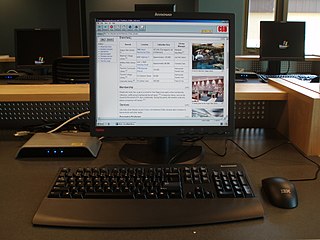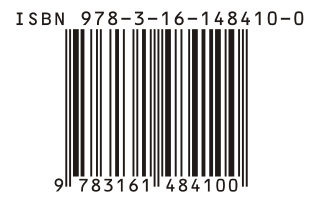
AIX is a series of proprietary Unix operating systems developed and sold by IBM for several of its computer platforms. Originally released for the IBM RT PC RISC workstation, AIX now supports or has supported a wide variety of hardware platforms, including the IBM RS/6000 series and later POWER and PowerPC-based systems, IBM System i, System/370 mainframes, PS/2 personal computers, and the Apple Network Server.

A thin client is a lightweight computer that has been optimized for establishing a remote connection with a server-based computing environment. The server does most of the work, which can include launching software programs, crunching numbers, and storing data. This contrasts with a fat client or a conventional personal computer; the former is also intended for working in a client–server model but has significant local processing power, while the latter aims to perform its function mostly locally.
Bonjour is Apple's implementation of zero-configuration networking (zeroconf), a group of technologies that includes service discovery, address assignment, and hostname resolution. Bonjour locates devices such as printers, other computers, and the services that those devices offer on a local network using multicast Domain Name System (mDNS) service records.

In computing, Virtual Network Computing (VNC) is a graphical desktop-sharing system that uses the Remote Frame Buffer protocol (RFB) to remotely control another computer. It transmits the keyboard and mouse events from one computer to another, relaying the graphical-screen updates back in the other direction, over a network.

HP 9000 is a line of workstation and server computer systems produced by the Hewlett-Packard Company (HP). The native operating system for almost all HP 9000 systems is HP-UX, which is based on UNIX System V. The HP 9000 brand was introduced in 1984 to encompass several existing technical workstation models previously launched in the early 1980s.
HP Integrity is a series of server computers produced by Hewlett Packard Enterprise since 2003, based on the Itanium processor. The Integrity brand name was inherited by HP from Tandem Computers via Compaq.
Software Distributor (SD) is the Hewlett-Packard company's name for their HP-UX software package management system.
Rocky Mountain BASIC is a dialect of the BASIC programming language created by Hewlett-Packard. It was especially popular for control of automatic test equipment using GPIB. It has several features which are or were unusual in BASIC dialects, such as event-driven operation, extensive external I/O support, complex number support, and matrix manipulation functions. Today, RMB is mainly used in environments where an investment in RMB software, hardware, or expertise already exists.
RIS, Remote Installation Services is a Microsoft-supplied server that allows PXE BIOS-enabled computers to remotely execute boot environment variables.

In systems management, out-of-band management involves the use of management interfaces for managing servers and networking equipment.
Integrity Virtual Machines is software from Hewlett-Packard that allows multiple virtual machines to run concurrently on any Itanium server running HP-UX, notably the HP Integrity line. It is part of HP's Virtual Server Environment suite.
Windows Vista contains a range of new technologies and features that are intended to help network administrators and power users better manage their systems. Notable changes include a complete replacement of the "Windows Setup" process, completely rewritten deployment mechanisms, support for per-application Remote Desktop sessions, new diagnostic and health monitoring tools, and a range of new Group Policy settings covering many of the features new to Windows Vista.
In computing, the term remote desktop refers to a software or operating system feature that allows a personal computer's desktop environment to be run remotely on one system, while being displayed on a separate client device. Remote desktop applications have varying features. Some allow attaching to an existing user's session and "remote controlling", either displaying the remote control session or blanking the screen. Taking over a desktop remotely is a form of remote administration.
This page is a comparison of remote desktop software available for various platforms.
Adaptive Internet Protocol (AIP) is a multi-channel protocol that allows an application running on any of multiple platforms to be displayed on any of a wide range of client systems. It supports rich remote display and input services with a number of display options to deliver the presentation of the remote applications onto the local display either as a standalone window, or within a contained remote environment delivered full-screen or in a standalone window. The protocol also supports audio, printing, and other device mapping services.
nPar partitions are electrically isolated from other nPar partitions within the same chassis. Cells make up nPar partitions. Being electrically isolated means that if a nPar partition were to fail due to hardware failure, then the other nPar partitions would continue to work. This is contrasted with vPar partitions which exist within nPar partitions in which a failure at the hardware level for a nPar would affect all vPars within that nPar.

GraphOn GO-Global is remote access/application publishing software that allows users to access and run Windows, Linux, and UNIX applications installed on a central server. GO-Global displays the application's user interface on personal computers and other client devices running a variety of operating systems, including UNIX, Linux, Mac OS X, Windows, Windows Mobile, and Pocket PC. GO-Global can be used to Web-enable existing applications without the need to modify existing code. Applications appear on the client device either in a Web browser or within a loose window on the desktop.
IBM BigFix formerly IBM Endpoint Manager, Tivoli Endpoint Manager (TEM) and before that, BigFix, is a systems-management software product developed by IBM for managing large groups of computers running Windows, Mac OS X, VMware ESX, Linux or UNIX, as well as various mobile operating systems such as Windows Phone, Symbian, iOS and Android. IBM BigFix provides system administrators with remote control, patch management, software distribution, operating system deployment, network access protection and hardware and software inventory functionality.
A printing protocol is an Internet protocol for communication between client devices and printers. It allows clients to submit one or more print jobs to the printer or print server, and perform tasks such as querying the status of a printer, obtaining the status of print jobs, or cancelling individual print jobs.









